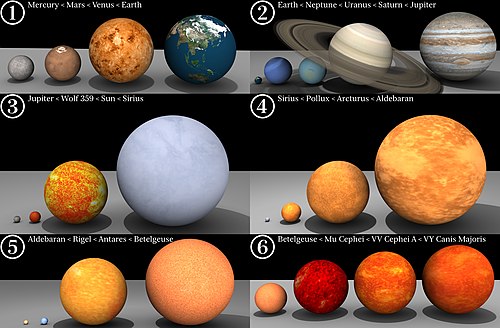Daftar bintang terbesar
Daftar ini belum tentu lengkap. Anda dapat membantu Wikipedia dengan mengembangkannya. |
Di bawah ini adalah daftar bintang terbesar yang diketahui saat ini, diurutkan berdasarkan radius. Satuan pengukuran yang digunakan adalah jari-jari Matahari (kira-kira 695.700 km; 432.288 mi).

Ketidakpastian besar tetap ada pada keanggotaan dan urutan daftar, terutama ketika mendapatkan berbagai parameter yang digunakan dalam penghitungan, seperti bintang luminositas dan suhu efektif. Seringkali jari-jari bintang hanya dapat dinyatakan sebagai rata-rata atau dalam rentang nilai yang besar. Nilai untuk radius bintang sangat bervariasi di berbagai sumber dan untuk metode observasi yang berbeda.
Diameter sudut banyak bintang dapat diukur secara langsung menggunakan interferometri bintang. Metode lain dapat menggunakan okultasi bulan atau dari biner gerhana, yang dapat digunakan untuk menguji metode tidak langsung untuk menemukan jari-jari bintang. Hanya beberapa bintang supergiant berguna yang dapat disembunyikan oleh Bulan, termasuk Antares A (Alpha Scorpii A). Contoh biner gerhana adalah Epsilon Aurigae (Almaaz), VV Cephei, dan V766 Centauri (HR 5171). Pengukuran diameter sudut bisa jadi tidak konsisten karena batas atmosfer yang sangat tipis (opasitas) berbeda-beda bergantung pada panjang gelombang cahaya di mana bintang diamati.
Daftar
Referensi
- ^ Kesalahan pengutipan: Tag
<ref>tidak sah; tidak ditemukan teks untuk ref bernamathomas - ^ Ren, Yi; Jiang, Bi-Wei (2020-07-20). "On the Granulation and Irregular Variation of Red Supergiants". The Astrophysical Journal (dalam bahasa Inggris). 898 (1): 24. doi:10.3847/1538-4357/ab9c17. ISSN 1538-4357.
- ^ Humphreys, Roberta M.; Helmel, Greta; Jones, Terry J.; Gordon, Michael S. (2020-08). "Exploring the Mass Loss Histories of the Red Supergiants". arXiv e-prints (dalam bahasa Inggris): arXiv:2008.01108.
- ^ Cruzalèbes, P; Petrov, R G; Robbe-Dubois, S; Varga, J; Burtscher, L; Allouche, F; Berio, P; Hofmann, K-H; Hron, J (2019-12-11). "A catalogue of stellar diameters and fluxes for mid-infrared interferometry★". Monthly Notices of the Royal Astronomical Society (dalam bahasa Inggris). 490 (3): 3158–3176. doi:10.1093/mnras/stz2803. ISSN 0035-8711.
- ^ V838 Monocerotis
- ^ E. M. Levesque. "WOH G64: The Largest Star Known?". Astronomical Journal. Diakses tanggal 2010-07 16.
- ^ Habets, G. M. H. J.; Heintze, J. R. W. (1981). "Empirical bolometric corrections for the main-sequence". Astronomy and Astrophysics Supplement. 46: 193–237. Diakses tanggal 2010-03-14. Page 225 "Table IV" #178
- ^ Professor James B. (Jim) Kaler. "VV CEP (VV Cephei)". University of Illinois. Diakses tanggal 2010-03-15.
- ^ E. M. Levesque. "The Effective Temperature Scale of Galactic Red Supergiants: Cool, but Not as Cool As We Thought". Astrophysical Journal. Diakses tanggal 2010-07 16.
- ^ A NEW VLA-HIPPARCOS DISTANCE TO BETELGEUSE AND ITS IMPLICATIONS. Graham M. Harper et al 2008 The Astronomical Journal 135 1430-1440 doi: 10.1088/0004-6256/135/4/1430 [1]
- ^ Jim Kaler. 2009-06-26. Betelgeuse "0.047 seconds of arc, from which we find a true radius of between 4.1 (compromise distance) and 4.6 (larger distance) AU, … extended atmosphere, and the pulsations make it difficult to locate an actual "surface" to tell just how large the star actually is. … "size" of the star depends on the color of observation. Long-wave infrared … up to 5 AU and greater, … shorter-wave infrared … 3 AU. … Betelgeuse to be shrinking … not even round, but somewhat oval"
- ^ approximately 800, derived from the 1990 lunar occultation measurement of apparent diameter of 43.1 milliarcsec (up to ±1 milliarcsec error) (http://adsabs.harvard.edu/abs/1990A&A...230..355R page 361) together with 1997 parallax of 5.40 [1.68] milliarcsec (SIMBAD citing Hipparcos). The parallax gives a derived distance from 460 to 877 light years. This in turn yields an actual diameter from 653 to 1,246 solar radius. An average of 800 is used here.
- ^ http://vizier.u-strasbg.fr/viz-bin/VizieR-5?-out.add=.&-source=II/224/cadars&recno=10781
- ^ http://vizier.u-strasbg.fr/viz-bin/VizieR-5?-out.add=.&-source=II/224/cadars&recno=9837
- ^ http://vizier.u-strasbg.fr/viz-bin/VizieR-5?-out.add=.&-source=II/224/cadars&recno=2512
- ^ http://vizier.u-strasbg.fr/viz-bin/VizieR-5?-out.add=.&-source=II/224/cadars&recno=6127
- ^ http://vizier.u-strasbg.fr/viz-bin/VizieR-5?-out.add=.&-source=II/224/cadars&recno=10947
- ^ http://vizier.u-strasbg.fr/viz-bin/VizieR-5?-out.add=.&-source=II/224/cadars&recno=9107
- ^ http://www.eso.org/~mwittkow/publications/conferences/SPIECWo5491199.pdf
- ^ [2]
- ^ Nugent, Richard. "The Garnet Star". weblore.com. Diakses tanggal 2009-12-04.
DIAM .. m Cep 1224 ... V509 CAS 910 ... V382 CAR 747
- ^ Lamers, H. J. G. L. M. (February 6–10, 1995). "Observations and Interpretation of Luminous Blue Variables". Cape Town, South Africa: Astronomical Society of the Pacific: 176–191. Bibcode:1995ASPC...83..176L. Diakses tanggal 2009-03-25.
- ^ http://arxiv.org/abs/astro-ph/0411133
- ^ "Big and Giant Stars"
- ^ http://vizier.u-strasbg.fr/viz-bin/VizieR-5?-out.add=.&-source=II/224/cadars&recno=2526
- ^ Davis J, Booth AJ, Ireland MJ, Jacob AP, North JR, Owens SM, Robertson JG, Tango WJ, Tuthill PG, J.; Booth, A. J.; Ireland, M. J.; Jacob, A. P.; North, J. R.; Owens, S. M.; Robertson, J. G.; Tango, W. J.; Tuthill, P. G. (2007). "The Emergent Flux and Effective Temperature of Delta Canis Majoris". Publications of the Astronomical Society of Australia. 24: 151. doi:10.1071/AS07017. Diakses tanggal 28 May 2010.
- ^ [3]
- ^ http://etacar.umn.edu/etainfo/basic/
- ^ Gamma Crucis by Jim Kaler]
- ^ http://adsabs.harvard.edu/abs/2005astro.ph..2181R
Pranala luar
- Giant Stars An interactive website comparing the Earth and the Sun to some of the largest known stars
- Lowell Observatory Astronomers Identify Largest Stars Known
- BBC News Three largest stars identified
- Star Size comparison movie
- Google Video Planets and stars drawn to scale
- Universe Today What is the Biggest Star in the Universe?